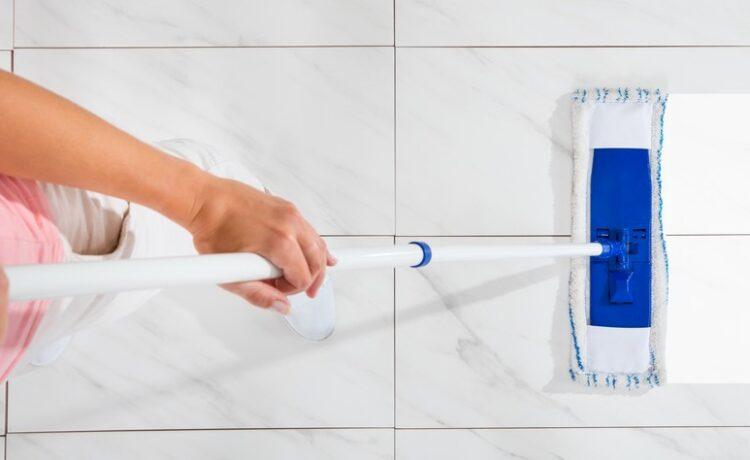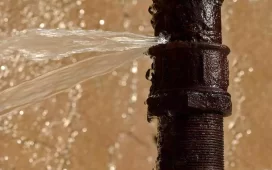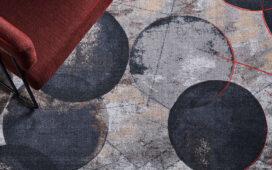Benefits of floor cleaning
Although flooring might not be your first thought when considering your business assets, its proper maintenance prevents costly replacement and repair expenses. With regular maintenance and cleaning of marble and tile floors, you can easily extend the life of your flooring investment.
Supply and Products for Floor Cleaning
Below are some instructions on how to clean marble floors. Before you get started, here are the professional cleaning supplies and floor cleaning products you’ll need:
- Broom and dustpan
- Soft, clean towel or rag
- Dish soap
- Mop
- Mop bucket with wringer
- Nylon brush
- Tile floor cleaner and marble floor cleaner
- Disinfecting floor cleaner
- No-rinse floor cleaner
- Degreasing floor cleaner
How to Clean Marble Floors
When it comes to marble floors, daily care is essential. Sand and dirt can scratch the surface if not kept off the floor; therefore, daily sweeping is crucial. Spills should be cleaned up immediately by wiping the spill and drying it thoroughly. Wine, lemonade, and other citrus juices will stain the surface– if left on the surface for too long, professional floor cleaning will be required to remove the stain.
Make sure to clean the spills immediately by wiping the spill and drying the area thoroughly.
General Care
- Clean the floor of all dirt, sand, and other debris.
- Use disinfecting floor cleaner to mop the floor. Marble is a soft rock that can be etched and stained by harsh cleaners, so make sure to use a pH-neutral cleaner.
- After mopping a section, dry the floor with a soft, clean rag or towel. This will prevent any water spotting and, of course, the risk of someone slipping.
Yearly Tips
- You can clean the surface with a pH-neutral marble restorer and dry it with a soft cloth if the marble starts to lose its shine.
- Have the floor buffed and sealed to keep it shiny and protect it from scratches.
How to Clean Tile Floors
- Sweep or vacuum the tile floor to remove dirt, dust and debris. This is essential as disinfecting a dirty tile floor can reduce the effectiveness of the disinfectant.
- Mix a solution of warm water and a disinfectant cleaner as per the product instructions. Most disinfectant cleaners work at a concentration of either 1:10 or 1:100, depending on the product. Make sure you read the instructions and use the mixture as directed. Alternatively, you can use a mixture of 1 part white vinegar or 1 tablespoon of bleach per gallon of water.
- Take a mop and dip it into the solution. Wring out the excess water. The mop should be damp but not soaking wet. Too much water can damage the grout between the tiles or cause streaks.
- Start mopping the floor. Begin from the farthest corner and work your way toward the door. To ensure complete coverage, overlap each section. Apply moderate pressure and move back and forth to remove any dirt or grime that may be stuck to the floor.
- Allow the disinfectant solution to sit on the floor for the time recommended on the product label. If you use vinegar or bleach solution, leave it on the floor for at least 5-10 mins. This will allow the disinfectant solution to kill any bacteria, viruses or other pathogens that may be present on the floor.
- Rinse the mop with clean water and go over the floor again to remove any remaining solution. This is necessary to ensure that no residue of the disinfectant or cleaning agent remains on the floor.
- Let the floor air dry, or dry it with a towel or mop. If using a towel or mop to dry the floor, ensure they are clean to avoid spreading dirt or bacteria.
Remember to always wear gloves when using disinfectants and work in a well-ventilated area. Also, make sure to follow the instructions on the disinfectant cleaner carefully, as some products may require extra precautions or steps.
Optional Wax
If applying a liquid floor wax, let the floor dry completely before applying. This will seal the floor and give it a glossy, shiny look. Apply the wax using a clean sponge. To avoid leaving footprints in the waxed areas, start at the back of your room and work your way towards the door. Allow the floor to dry for at least one hour.
FREQUENTLY ASKED QUESTIONS (FAQs)
Q: What are the major differences between marble and tiles?
Marble is a natural stone and is more durable, while tiles are artificially made. Tiles are made in a variety of styles and colours, while marble is not.
Q: How do I clean marble floors?
A: First, vacuum up all loose dirt and debris from marble floors. Use a pH-neutral cleaner that is specifically designed to clean marble floors. Avoid acidic or abrasive cleaners as they can cause damage to the marble floors. Use clean water to rinse the floor and then dry it using a towel or mop. It is also recommended to seal the marble to protect it from stains and damage.
Q: Can I use vinegar to clean marble floors?
A: Vinegar is not recommended for marble floors as it is an acidic substance that can etch and damage the surface. Use a pH-neutral cleaner that is specifically made for use on marble.
Q: How do I clean tile floors?
A: To clean tile floors, start by sweeping or vacuuming up any loose debris. Use a mop with a pH-neutral cleaner that is specifically designed to clean tile floors. Avoid using harsh or acidic cleaners as they can cause damage to the tile floor. Use clean water to rinse the floor and then dry it using a towel or mop.
Q: Can I use bleach to clean tile floors?
A: You should not use bleach to clean tile floors as it can damage the surface and cause discolouration.
Q: How often should I clean my marble or tile floors?
A: Marble or tile floors should be cleaned at least once a week or as often as necessary to remove dirt and debris. You should not overclean the tiles or use harsh cleaning agents that can damage the surfaces.
Q: How can I prevent damage to my marble or tile floors?
A: Avoid using harsh cleaners or abrasive scrubbers to prevent any damage to marble or tile floors. To prevent scratching or etching, clean up any spillages as quickly as possible. A professional sealant should be applied to protect the surface from stains or damage.
Q: Marble or tiles, which one is cheaper?
Tiles are more expensive than marble as they are manufactured by tiles companies, while marble occurs naturally.
Q: Does marble crack easily?
Marble is extremely durable and can withstand regular wear and tear. However, poor-quality of marble or faulty installation will lead to cracks and breaks.







